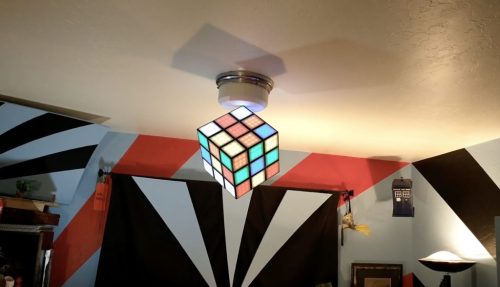- How to Adjust X and Y Axis Scale in Arduino Serial Plotter (No Extra Software Needed)Posted 7 months ago
- Elettronici Entusiasti: Inspiring Makers at Maker Faire Rome 2024Posted 7 months ago
- makeITcircular 2024 content launched – Part of Maker Faire Rome 2024Posted 9 months ago
- Application For Maker Faire Rome 2024: Deadline June 20thPosted 11 months ago
- Building a 3D Digital Clock with ArduinoPosted 1 year ago
- Creating a controller for Minecraft with realistic body movements using ArduinoPosted 1 year ago
- Snowflake with ArduinoPosted 1 year ago
- Holographic Christmas TreePosted 1 year ago
- Segstick: Build Your Own Self-Balancing Vehicle in Just 2 Days with ArduinoPosted 1 year ago
- ZSWatch: An Open-Source Smartwatch Project Based on the Zephyr Operating SystemPosted 1 year ago
Arduino-controlled Rubik’s cube chandelier solves itself
Rubik’s cubes have been mystifying and frustrating people for more than 40 years now. According to Forbes, 450 million Rubik’s cubes had been sold by 2020. But based on our very scientific estimates, only a small fraction of those have been solved. To avoid that difficulty, Stuart Gorman gave his Rubik’s cube chandelier the ability to unscramble itself.
This large 3D-printed chandelier looks exactly like the iconic cube, except that each section is lit by LEDs instead of covered with a sticker. Those are WS2812B individually-addressable RGB LEDs controlled by an Arduino Mega board. People usually choose the Mega when they need a lot of I/O pins, but in this case Gorman picked the Mega because it has lots of RAM to work with. That RAM is necessary for handling the complexity of the Arduino code that the lamp is running.

The lamp has a few different LED effects modes, which are selectable through a smartphone app that connects to the Arduino via a Bluetooth module. Static colors can be set to each face or it can flash random colors. But the exciting modes replicate traditional Rubik’s cube play. The first starts with a solved cube and then endlessly rotates random faces, like most people do when they attempt to solve a Rubik’s cube. The second mode will actually solve the cube, which it does by playing the first mode in reverse. This chandelier looks fantastic and is a lot of fun to watch in action.















